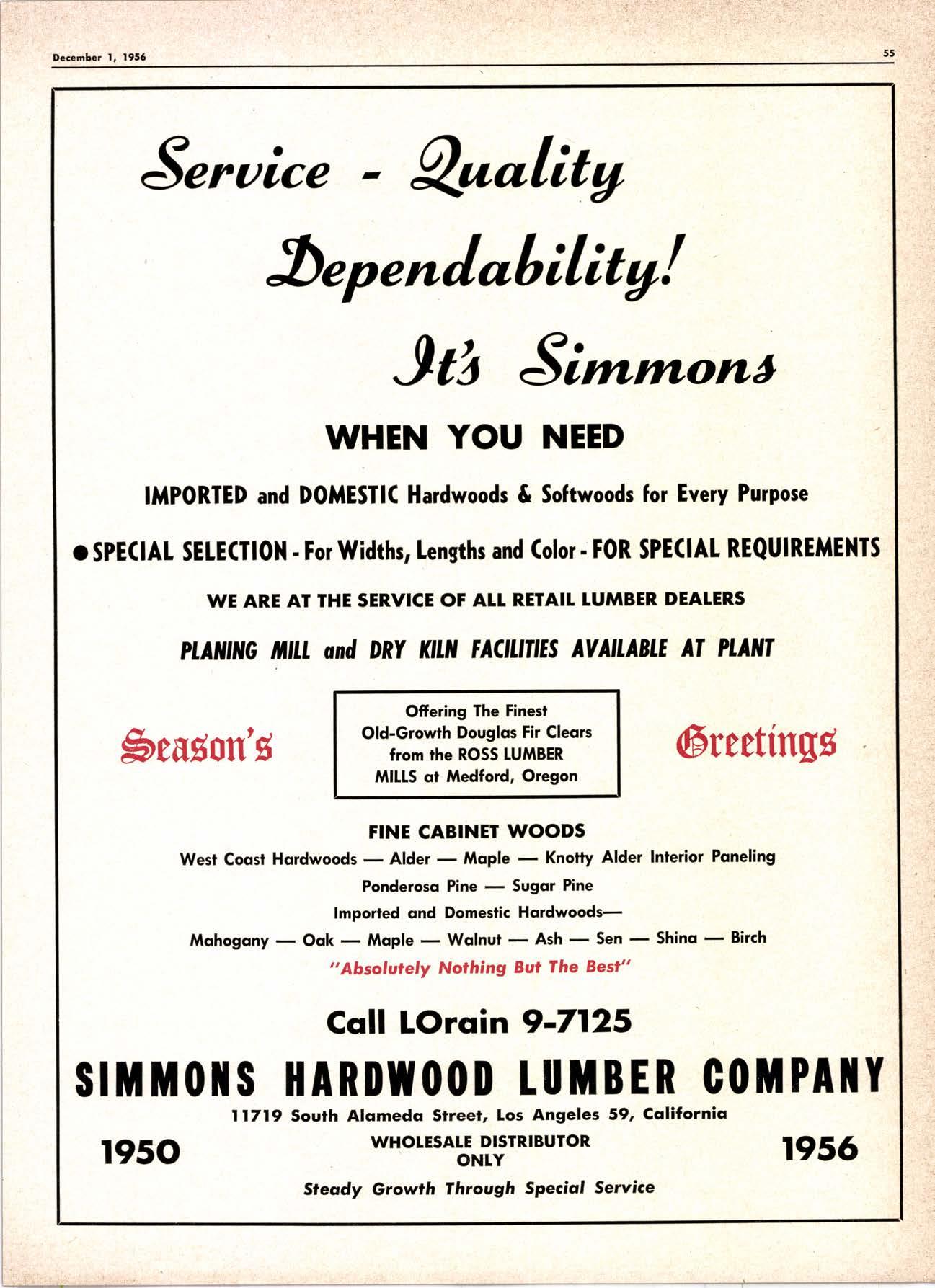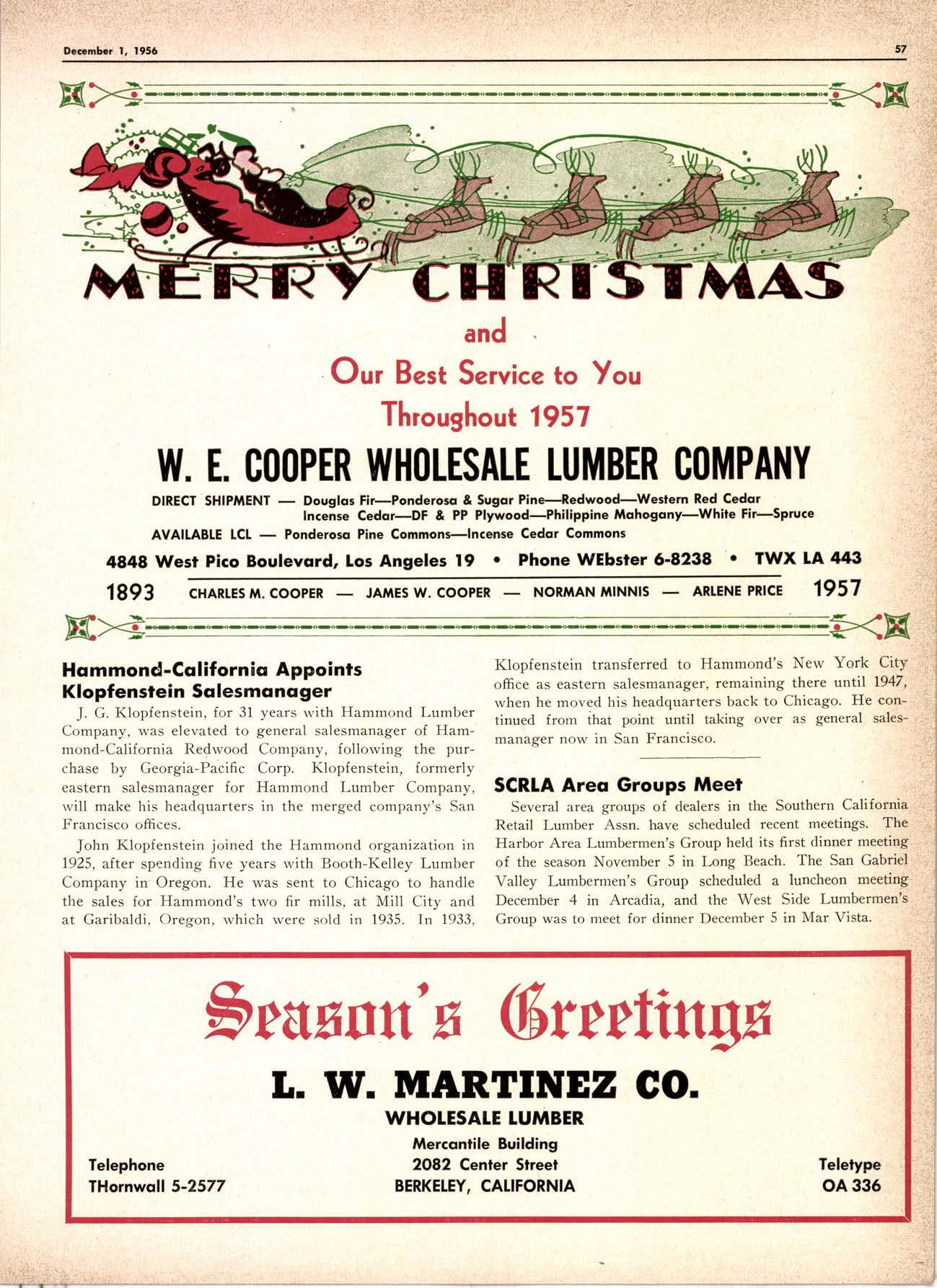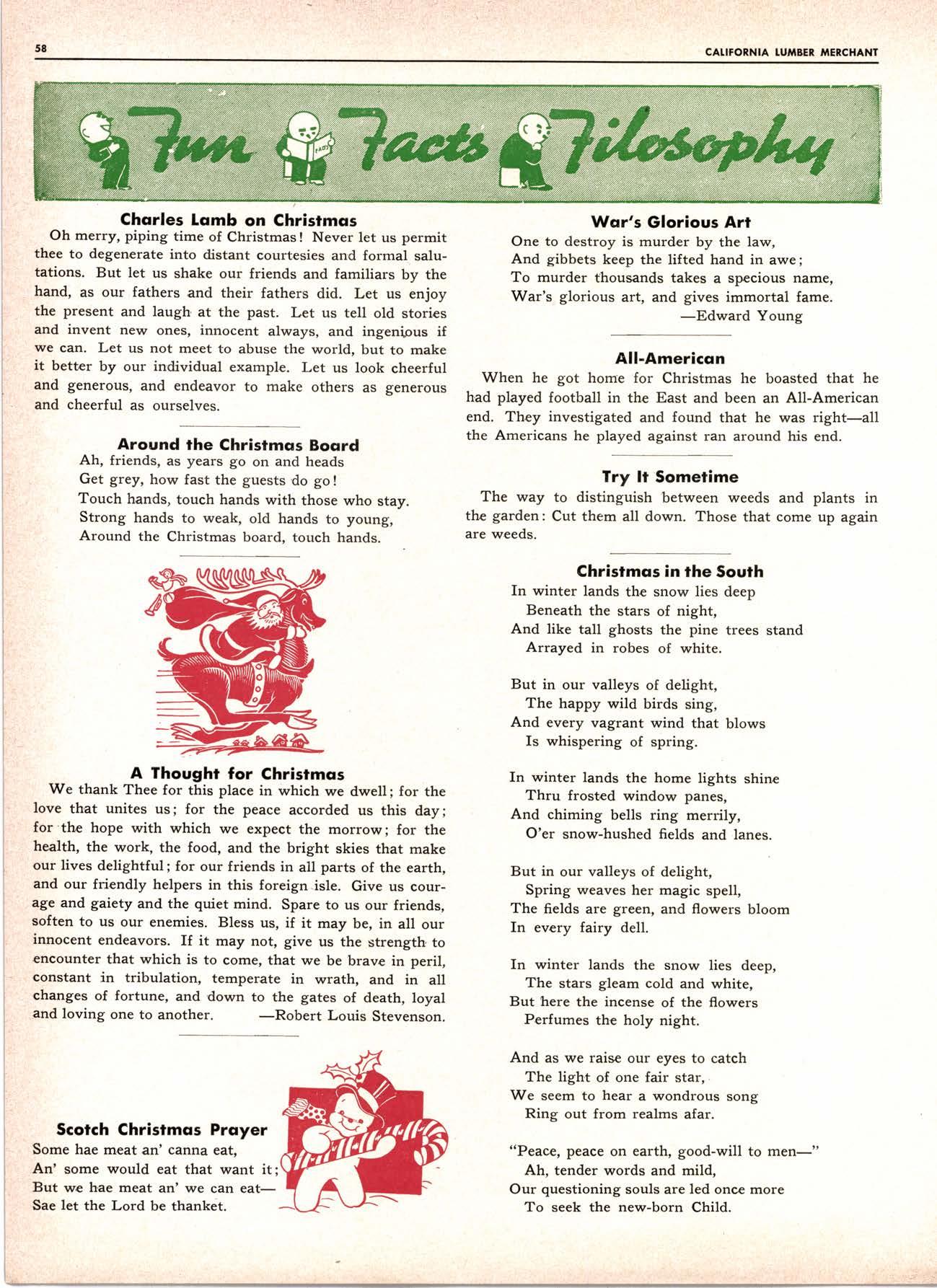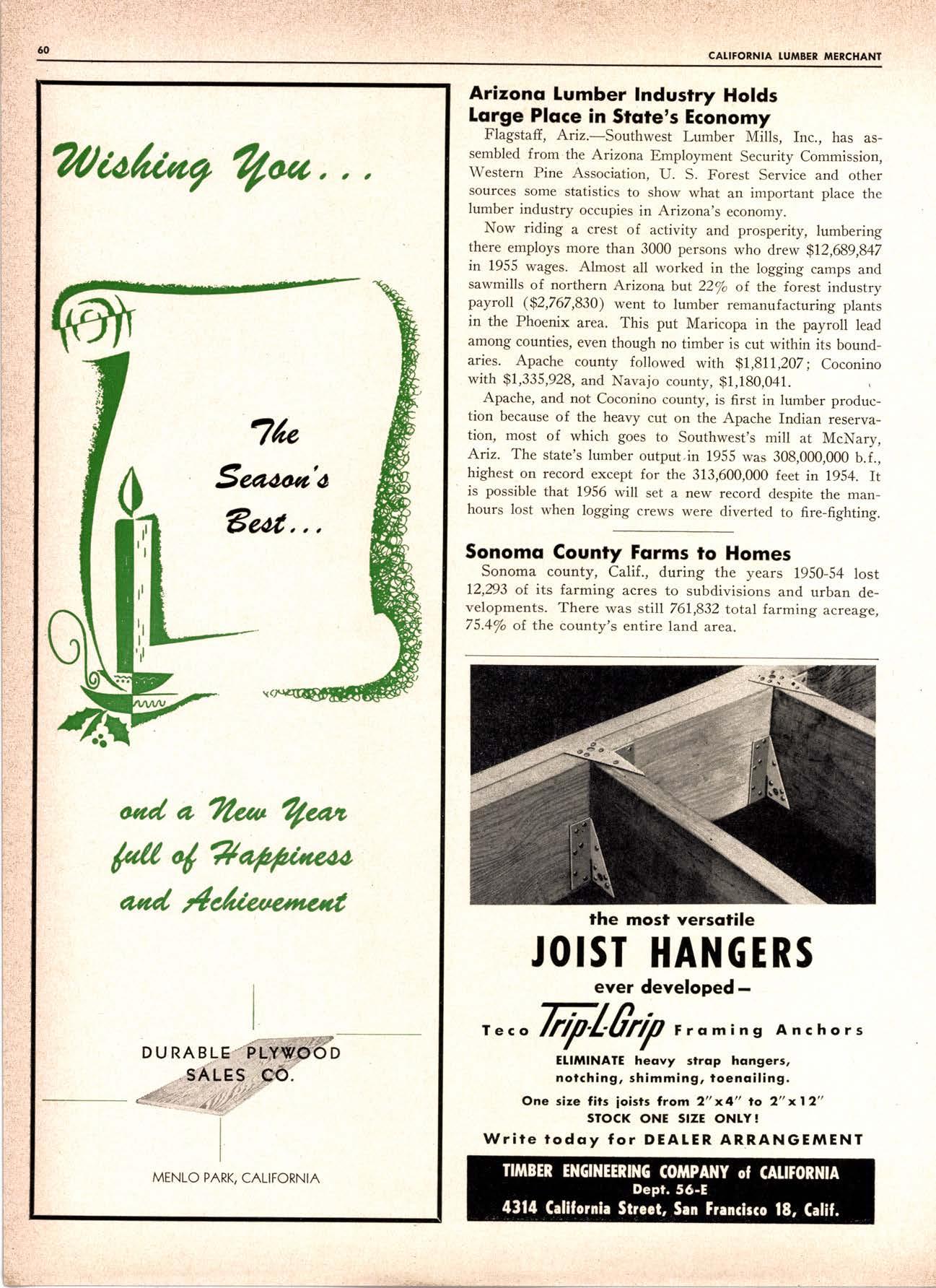
7 minute read
Snraice ' g-ohty Snpnnl,ob;l;ta! -ItI Sirnr*on{
When You Need
IIIPORTED and DOMESTI( Hardwoods & Softwoods for Every Purpose o SPE(lAt SELEfiI0N . For Widths, lensths and (olor - FOR SPE(lAt REQUIREIIE]ITS
WE AR,E AT THE SER,VICE OF Att RETAIL IUI,IBER, DEAIER,S
PLANNG ffiLL ANI DRT K'LII TAilL|iNES AVAILABIE AI PIAM
9rugon's
Ofiering The Finest
Old-Growlh Douglos Fir Cleqrs from the ROSS tUI BER Mltts ot Medford, Oregon
FINE CABINET WOODS
West Coost HordwoodsAlderMopteKnoily Alder lnterior Poneling
Ponderoso PineSugor Pine lmporled ond Domeslic HordwoodsilohogonyoqkMoplewqlnutAshSenshinoBirch "AhsolutelY Nofhing But fhe Besl"
Ccrll LOroin 9-7125
Slltlttl 0llS HARllil00D tUltlBER ll7l9 South Alqmedn Slreet, los Angeles 59' Colifornin
Klomoth Indicns Foce Tribol Tussle On Selling Voluoble Timberlonds
Chiloquin, Ore.-Almost a century ago, by an ,,X" on a treaty, La-I-ake, Che-mult, Boss-ki-you and other braves among the People of the Chipmunks signed away their tribal freedom for life on a reservation ruled by the U. S. government. Today, their Klamath Indian tribe descendants are finding it takes more than a mere act of Congress to put them back in charge of their affairs, and in control of property worth $80 million, The Wall Street Journal recently, reported. Sitting on the sun porch of a brown and white home in a pine grove, aging Seldon E. Kirk, the tribe's bronzed, crewcut chief who drives a '56 Cadillac instead of riding a war pony, and wears a red and yellow Hawaiian sport shirt re_ splendent with dancing hula girls, sums up his brethren's dilemma: "Some members want to sell their share in the reservation. Some don't. She's a problem.', The real problem is how the Indians' valuable timber lands in southern Oregon will be handled under a new Federal policy aimed at putting the Red Men on their own. The 2,000 Klamaths have owned the land all along, but the U. S. Government managed it as a trustee, earning a good deal of warrpum for members of the tribe in the process. Now the Indians are faced with selling their timber land, or managing it themselves wiihout Government help. Furthermore, the Klamath policy is viewed as a guide to future Federal moves to end supervision over 425,000 Indians and some 53 million acres of Indian-owned land around the country.
The million-acre Klamath reservation, with its stands of red-barked ponderosa pine, is worth about $160,000 to each average-size family of four in the tribe. Suddenly handing this money, or manag'ement of the vast timber tract, to the Klamaths is bound to create problems for the Indians, the community and a variety of businessmen, according to both tribal and outside authorities.
In addition to problems created for individual Indians, many of whom knorv only a subsidized reservation life, the change will affect some big and small businesses. Sawmills over a u'ide area may feel the pressure of largescale sales of Indian timber.
Weyerhaeuser Timber Co. owns about 90,000 acres of land that now is almost surrounded by the reservation. And on the reservation itself, Johns-Manville Corp. owns a site for a proposed 915 million insulation board trill.
The policy behind "the freeing of the Klamaths" also airrs eventually at ending Govern_ ment management of some other tribes' lucrative business-including oil and gas lancls owned by the Osages in Oklahoma, uranium deposits be_ longing to the Spokanes in Washington, phos_ phate owned by the Shoshone-Bannock tribes in Idaho, oil belonging to the Dakotas and a saw_ mill run by Southwestern Navajos.

U. S. taxpayers also hat e a big stake in the new policy. More than $1.7 billion has been spent by the Federal Government for adminis_ tering Indian affairs since 1900.
The problem facing the Klamaths, of course, isn't typical of the troubles of all U. S. Indians. 70,000 Navajos, for example, are trying to eke a living from 25,000 barren reservation acres in the Southwest. The land can support fewer than half the people living on it, offrcials have stated. This so-called reservation termination law gives each tribe member two alternatives. Ife can elect to sell his share of the tribal assets when a property appraisal is completed next February. Or he can become an equal-share owner in a corporation or other unit that will run the "freed" reservation as a business.
The hitch is that so many Klamaths-perhaps half or three-fourths of the tribe-apparently want to sell their shares of tribal property irnmediately. Worry as to what this large-scale liquidation rvould do to the Indians and the surrounding community has sparked a move to get Uncle Sam to buy the entire Klamath Reservation.
and Out Best Service to You Throughout 1957

W. E. CtltlPER WHOTESALE TUMBER CIIMPANY
Hqmmond-Colifornio Appoints
Klopfenstein Sqlesmqnoger
J. G. Klopfenstein, for 31 years rvith }lammond Lumber Company, rn'as elevated to general salesmanager of Hammond-California Red'ivood Company, follor,ving the purchase by Georgia-Pacific Corp. Klopfenstein, formerly eastern salesmanager for Hammond Lumber Company, t'ill make his headquarters in the merged company's San Francisco offices.
John Klopfenstein joined the Hammond organization in 1925, after spending five years with Booth-Kelley Lumber Company in Oregon. He was sent to Chicago to handle the sales for Hammond's two fir mills, at Mill City and at Garibaldi, C)regon, which were sold in 1935. In 1933,
Klopfenstein transferred to Hammond's office as eastern salesmanager, remaining rvhen he moved his headquarters back to tinued from ihat point until taking over manager now in San Francisco.
SCRTA Areq Groups Meet
New York City
' there until 1947, Chicago. He conas general sales-
Several area groups of dealers in the Southern California Retail Lumber Assn. have scheduled recent meetings. The Harbor Area Lumbermen's Group held its first dinner meeting of the season November 5 in Long Beach. The San Gabriel Valley Lumbermen's Group scheduled a luncheon meeting December 4 in Arcadia, and the West Side Lumbermen's Group was to meet for dinner Decernber 5 in Mar Vista.
Chorles lomb on Christmqs
Oh merry, piping time of Christmas ! Never let us permit thee to degenerate into distant courtesies and formal salutations. But let us shake our friends and familiars by the hand, as our fathers and their fathers did. Let us enjoy the present and laugh at the past. L€t us tell old stories and invent new ones, innocent always, and ingenipus if we can. Let us not meet to abuse the world, but to make it better by our individual example. Let us look cheerful and generous, and endeavor to make others as generous and cheerful as ourselves.
Around rhe Chrisrmqs Boqrd
Ah, friends, as years go on and heads
Get grey, how fast the guests do go!
Touch hands, touch hands with those who stay.
Strong hands to weak, old hands to young, Around the Christmas board, touch hands.
Wor's Glorious Art
One to destroy is murder by the law, And gibbets keep the lifted hand in awe; To murder thousands takes a specious name, War's glorious art, and gives immortal fame.
-Edward Young
All-Americon
When he got home for Christmas he boasted that he had played football in the East and been an All-American end. They investigated and found that he was right-all the Americans he played against ran around his end.
Try lt Sometime
The way to distinguish between weeds and plants in the garden: Cut them all down. Those that come up again are weeds.

Ghristmqs in the South
In winter lands the snow lies deep Beneath the stars of night, And like tall ghosts the pine trees stand Arrayed in robes of white.
But in our valleys of delight, The happy wild birds sing, And every vagrant wind that blows Is whispering of spring.
A Thought for Christmos
We thank Thee for this place in which we dwell; for the love that unites us; for the peace accorded us this day; forthe hope with which we expect the morrow; for the health, the work, the food, and the bright skies that make our lives delightful; for our friends in all parts of the earth, and our friendly helpers in this foreign-isle. Give us courage and gaiety and the quiet mind. Spare to us our friends, soften to us our enemies. Bless us, if it may be, in all our innocent endeavors. If it may not, give us the strength.to encounter that which is to come, that we be brave in peril, constant in tribulation, temperate in wrath, and in all changes of fortune, and down to the gates of death, loyal and loving one to another.
-Robert Louis Stevenson.
Scotch Christmqs Proyer
Some hae meat an' canna eat, An' some would eat that want it; But we hae meat an' we can eatSae let the Lord be thanket.
In winter lands the home lights shine Thru frosted window panes, And chiming bells ring merrily, O'er snow-hushed fields and lanes.
But in our valleys of delight, Spring weaves her magic spell, The fields are green, and flowers bloom In every fairy dell.
In winter lands the snow lies deep, The stars gleam cold and white, But here the incense of the fowers Perfumes the holy night.
And as we raise our eyes to catch The light of one fair star,. We seem to hear a wondrous song Ring out from realms afar.
"Peac€, peace on earth, good-will 1e s1s11-" Ah, tender words and mild, Our questioning souls are led onc€ more To seek the new-born Child.

Arizono lumber Industry Holds Lorge Ploce in Stofe's Economy
Flagstaff, Ariz.-Southwest Lumber Mills, Inc., has assembled from the Arizona Employment Security Commission, Western Pine Association, U. S. Forest Service and other sources some statistics to show what an important place the lumber industry occupies in Arizona's economy.

Now riding a crest of activity and prosperity, lumbering there employs more than 3000 persons who drew $t2,6f;9,842 in 1955 wages. Almost all worked in the logging camps and sawmills of northern Arizona but 22Vo of the forest industrv payroll ($2,767,830) went to lumber remanufacturing plants in the Phoenix area, This put Maricopa in the payroll lead among counties, even though no timber is cut within its boundaries. Apache county followed with 91,811 ,207; Coconino with $1,335,928, and Navajo county, $1,180,041.
Apache, and not Coconino county, is first in lumber production because of the heavy cut on the Apache Indian reservation, most of which goes to Southwest's mill at McNary, Ariz. The state's lumber output.in 1955 was 308,000,000 b.f., highest on record except for the 313,600,000 feet in 1954. It is possible that 1956 will set a new record despite the manhours lost when logging crews were diverted to fire-fighting.
Sonomo Counfy Fqrms to Homes
Sonoma county, Calif., during the years 1950-54 lost 12,D3 of its farming acres to subdivisions and urban develgpments. There was still 761,832 total farming acreag.e, 75.4% of the county's entire land area.










